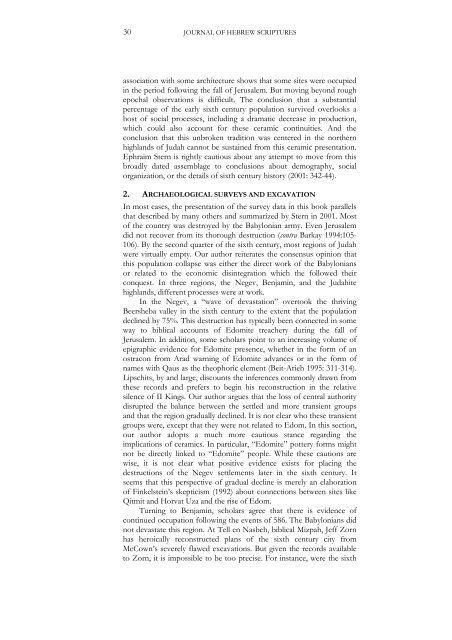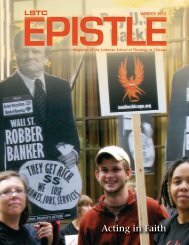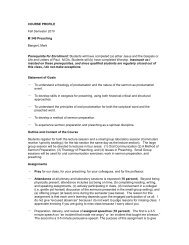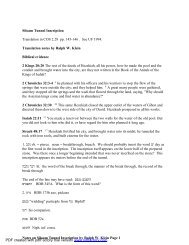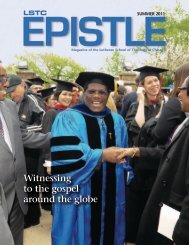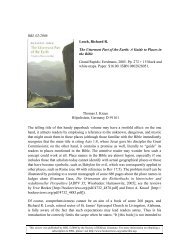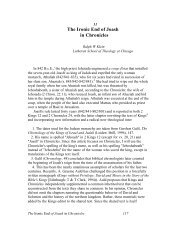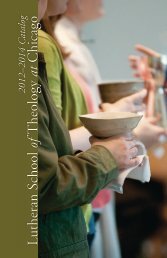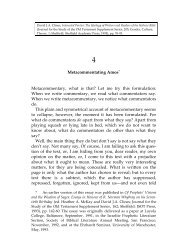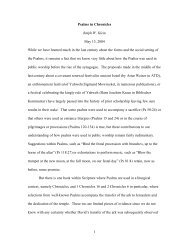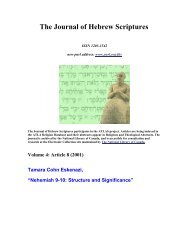Download this PDF file - University of Alberta - Journal Hosting
Download this PDF file - University of Alberta - Journal Hosting
Download this PDF file - University of Alberta - Journal Hosting
Create successful ePaper yourself
Turn your PDF publications into a flip-book with our unique Google optimized e-Paper software.
30JOURNAL OF HEBREW SCRIPTURESassociation with some architecture shows that some sites were occupiedin the period following the fall <strong>of</strong> Jerusalem. But moving beyond roughepochal observations is difficult. The conclusion that a substantialpercentage <strong>of</strong> the early sixth century population survived overlooks ahost <strong>of</strong> social processes, including a dramatic decrease in production,which could also account for these ceramic continuities. And theconclusion that <strong>this</strong> unbroken tradition was centered in the northernhighlands <strong>of</strong> Judah cannot be sustained from <strong>this</strong> ceramic presentation.Ephraim Stern is rightly cautious about any attempt to move from <strong>this</strong>broadly dated assemblage to conclusions about demography, socialorganization, or the details <strong>of</strong> sixth century history (2001: 342-44).2. ARCHAEOLOGICAL SURVEYS AND EXCAVATIONIn most cases, the presentation <strong>of</strong> the survey data in <strong>this</strong> book parallelsthat described by many others and summarized by Stern in 2001. Most<strong>of</strong> the country was destroyed by the Babylonian army. Even Jerusalemdid not recover from its thorough destruction (contra Barkay 1994:105-106). By the second quarter <strong>of</strong> the sixth century, most regions <strong>of</strong> Judahwere virtually empty. Our author reiterates the consensus opinion that<strong>this</strong> population collapse was either the direct work <strong>of</strong> the Babyloniansor related to the economic disintegration which the followed theirconquest. In three regions, the Negev, Benjamin, and the Judahitehighlands, different processes were at work.In the Negev, a “wave <strong>of</strong> devastation” overtook the thrivingBeersheba valley in the sixth century to the extent that the populationdeclined by 75%. This destruction has typically been connected in someway to biblical accounts <strong>of</strong> Edomite treachery during the fall <strong>of</strong>Jerusalem. In addition, some scholars point to an increasing volume <strong>of</strong>epigraphic evidence for Edomite presence, whether in the form <strong>of</strong> anostracon from Arad warning <strong>of</strong> Edomite advances or in the form <strong>of</strong>names with Qaus as the theophoric element (Beit-Arieh 1995: 311-314).Lipschits, by and large, discounts the inferences commonly drawn fromthese records and prefers to begin his reconstruction in the relativesilence <strong>of</strong> II Kings. Our author argues that the loss <strong>of</strong> central authoritydisrupted the balance between the settled and more transient groupsand that the region gradually declined. It is not clear who these transientgroups were, except that they were not related to Edom. In <strong>this</strong> section,our author adopts a much more cautious stance regarding theimplications <strong>of</strong> ceramics. In particular, “Edomite” pottery forms mightnot be directly linked to “Edomite” people. While these cautions arewise, it is not clear what positive evidence exists for placing thedestructions <strong>of</strong> the Negev settlements later in the sixth century. Itseems that <strong>this</strong> perspective <strong>of</strong> gradual decline is merely an elaboration<strong>of</strong> Finkelstein’s skepticism (1992) about connections between sites likeQitmit and Horvat Uza and the rise <strong>of</strong> Edom.Turning to Benjamin, scholars agree that there is evidence <strong>of</strong>continued occupation following the events <strong>of</strong> 586. The Babylonians didnot devastate <strong>this</strong> region. At Tell en Nasbeh, biblical Mizpah, Jeff Zornhas heroically reconstructed plans <strong>of</strong> the sixth century city fromMcCown’s severely flawed excavations. But given the records availableto Zorn, it is impossible to be too precise. For instance, were the sixth


